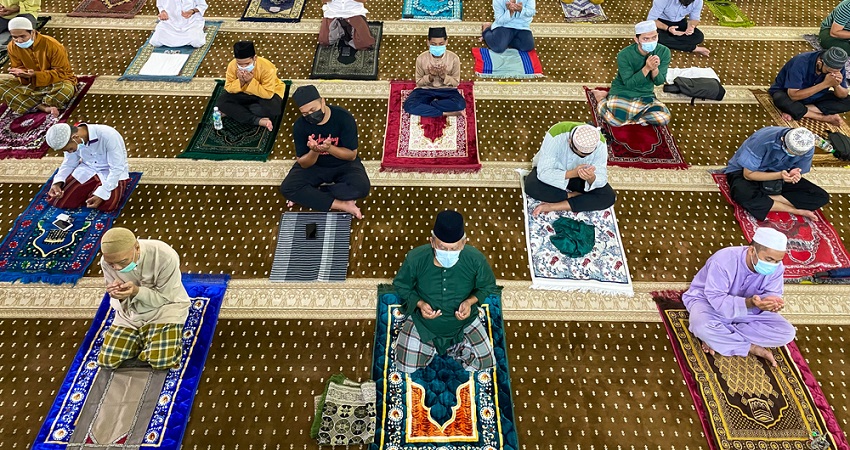Taraweeh Prayer is the most spiritual and blissful practice observed during Ramadan. For an entire month, Muslims gather in mosques to hear and reflect on the recitation of the Quran. Taraweeh is performed after Isha and comprises twenty Rakats that are performed throughout Ramadan, between the night prayer (Salat-Al-Isha) and the odd-numbered prayer (Salat-Al-Witr). In this blog we look at everything about this special prayer – its meaning and origin, rewards and benefits, Taraweeh prayer method, steps for ladies, niyyat and tasbeeh for taraweeh, and more.
What is Taraweeh prayer?

Taraweeh prayers are night prayers said during the nights of Ramadan. They are offered between Isha and Witr prayers. These prayers were said by the Prophet (peace and blessings be upon him), and all Muslims try to follow in his footsteps. Depending on a number of factors, Taraweeh may be prayed at a mosque or at home. However, Taraweeh in a mosque congregation is considered most rewarding.
Taraweeh Meaning and Origin
The word Taraweeh is derived from an Arabic word that means to rest and relax. They are called Taraweeh because ancestors used to rest after every Rakat. After all, the prayers used to be extensive. These prayers are also known as “Qiyam-Ul Layl” (night prayers) as they can be performed till midnight.
In the final year of his life, one night Prophet Muhammad (PBUH) came out and prayed Taraweeh, some people accompanied him. On the second and third nights as the word spread, more people joined in for Taraweeh. On the fourth day, the mosque was crowded, and everybody waited for the Prophet’s arrival.
However, he prayed at home by himself and said, “Nothing prevented me from coming out to you except the fact that I feared that it would be made obligatory for you.”
Taraweeh Prayer Benefits

Taraweeh blessings and rewards in the holy month of Ramadan have been mentioned in the Hadith, as said by the Prophet,
“Whoever stands for prayer (the night prayer) during Ramadan with iman (faith), hoping for rewards, all his/her previous sins will be forgiven.”
“Whoever draws nearer (to Allah) by performing any of the (optional) good deeds in (this month) shall receive the same reward as performing an obligatory deed at any other time, and whoever discharges an obligatory deed in (this month) shall receive the reward of performing seventy obligations at any other time.”
Besides spiritual rewards, offering Taraweeh also yields many physical benefits such as:
Enhanced Physical and Emotional Health: The gentle shifting movements that are done during performing Sajdah and Raku enhance physical and emotional health as well as increase the life expectancy of the person praying. It has also been seen that those who fast the entire day and then perform Taraweeh prayers feel strong at night.
Better Muscle Strength in the Elderly: With the age increasing every day, physical movements tend to decrease in elderly people which often leads to many medical problems. The constant movement that happens during Taraweeh prayers gives muscle strength, improves joint flexibility as well as reduces tiredness. It also helps in restoring mineral content deficiency and acts as a lubricator for joints.
Enhanced Mental Health: Exercise is beneficial not only for physical health but for mental health as well. It improves the quality of life as it makes a positive impact on behavior and thought processes. The gentle up and down movements are not only a source of physical exercise but also a source of relaxed mood and mindset.
Niyat for Taraweeh
One offering prayer at home or alone should declare the following Taraweeh Niyat:
“I intend to pray the Sunnah prayer of Terawih four raka’at for Allah ta’ala”
If one is praying in a congregation, the niyat for Terawih prayer is mentioned below. The Imam or who is leading the prayer must say:
“I intend to pray the Sunnah prayer of Terawih as the Imam four raka’at for Allah ta’ala”
The Makmum or follower will recite the following behind Imam:
“I intend to pray the Sunnah prayer of Terawih as the Makmum four raka’at for Allah ta’ala”.
How to perform Taraweeh Prayer?

The majority agrees that Taraweeh prayer should be offered at the congregation in the mosque as it is more fruitful, but the congregational worship can be done at home as well. The prayer can be performed in four Rakats. When it is performed in four Rakats, it is like the sunnah of the late afternoon prayer (Salat-Al-Asr).
Choice of Prayer
Before beginning, certain things should be ensured like deciding how many Rakat prayers you would like to perform. If the prayer is done two by two and is concluded with Witr prayer, it would be considered following the Sunnah. After that, it should be ensured that the area is clean and free of impurities.
Ablution
If you are not pure for the ritual, Wudu must be performed. When entering the Mosque, you must stand quietly away from the entrance/exit, so you do not disturb others. If required, one must perform Ghusl (full shower) instead of Wudu. Men must cover the area between their navel and knees while women must cover everything except their face and hands.
Suggested Read: A Complete Guide To Ghusl
The prayer begins by setting the intention that you are praying for Taraweeh. Then you must raise your hands to your ears and say Allahu Akbar which means Allah is the greatest. After that, you must put your hand either on your navel or on your chest. You should not be distracted so it is suggested that you fix your eyes on the place of prostration. Then you must recite the opening dua which is Du’a al Istifah and after that Surah al Fātiḥah which must be recited in every four Rakats of Taraweeh. After completing the Surah Al-Fatihah, one can read any surah of their preference that the individual has memorized. For the 2nd rakat, one should choose the verse that does not come before the first as per the holy Quran. For example, one can recite Surah Al-’Asr in 1st rakat and then read Surah Al-Ikhlas in 2nd rakat, or one can recite the same Surah in the second Rakat.
You have to say Allahu Akbar and then bend down which is known as the Ruku position. While bowing, you have to say Subhana Rabbiyal Adheem thrice. Then you must rise from your Ruku position and recite Sami-Allah Huliman Hamidah.
In the next step, you have to say Allahu Akbar and prostrate to take the Sajdah position. Then rise from the Sajdah position and sit on your knees and recite duas. Say Allahu Akbar and stand up and this will mark the completion of one Rakat. The second Rakat is supposed to be done the same way. After the second prayer, finish with tasleem. You can pray if you want in the pair of two-by-two and perform Niyat in between.
How to pray taraweeh for ladies step-by-step
Women should perform Salaah for Esha (four optional sunnats for Gayr Muakkadah, four fardh, two Muakkadh Sunnah, and two Nafl). Following this, they have to do 20 Taraweeh Rakats in sections of 4 Rakats (Salaam after every 2 Rakats). After every 4 Rakats, one has to recite dua for Taraweeh. This completes Taraweeh for ladies.
Tasbeeh for Taraweeh
Given Below is the Tasbeeh for Taraweeh:
Subhana dhil Mulki wal Malakuti;
Subhana dhil izzati wal aDhmati wal haybati wal Qudrati;
wal kibriyaa’i wal jabaroot;
Subhanal Malikil hayyil ladhi, la yunaamu wa layamutu;
Subbuhun, Quddusun, Rabbuna Rabbul malaa’ikati war-rooh;
Allahumma Ajirnee Minan Naar;
Ya Mujeero, Ya Mujeero, Ya Mujeer.
Meaning – “Pure is He (Allah), the Owner of the Kingdom and the Sovereignty; Pure is He, the Owner of Honour, and Greatness, and Reverence, and Power, and Superiority, and Might; Pure is the Real King Who is Alive – there is neither sleep nor death for Him; He is the Utmost Pure, and the Holy, the Master of all Angels and of the Spirit; O Allah !! Save us from the fire – O Saviour, O Emancipator, O Protector”.
Dua during Taraweeh prayer
The following Taraweeh dua is recommended by Islamic scholars:
سُبْحَانَ ذِی الْمُلْکِ وَالْمَلَکُوْتِ ط سُبْحَانَ ذِی الْعِزَّةِ وَالْعَظَمَةِ وَالْهَيْبَةِ وَالْقُدْرَةِ وَالْکِبْرِيَآئِ وَالْجَبَرُوْتِ ط سُبْحَانَ الْمَلِکِ الْحَيِ الَّذِی لَا يَنَامُ وَلَا يَمُوْتُ سُبُّوحٌ قُدُّوْسٌ رَبُّنَا وَرَبُّ الْمَلَائِکَةِ وَالرُّوْحِ ط اَللّٰهُمَّ اَجِرْنَا مِنَ النَّارِ يَا مُجِيْرُ يَا مُجِيْرُ يَا مُجِيْر۔
Meaning: “Exalted is the Possessor of the hidden and the manifest dominion. Exalted is the Possessor of Might, Greatness, Reverence, Power, Pride, and Majesty. Exalted is the Master, the Living, the one who neither sleeps nor dies. All-perfect, All-holy, Our Lord, and the Lord of the angels and the souls. O Allah, grant us refuge from the Hellfire. O Granter of refuge, O Granter of refuge, O Granter of refuge”.
However, one should note that there is no particular hadith referring to the mentioned taraweeh prayer dua. Hence, there is no sunnah for a dua after Taraweeh. Dua e taraweeh can only be offered with the intent of receiving more benefits and blessings of Taraweeh prayer.
Is Taraweeh mandatory?
Though there are several types of prayers that are obligatory, offering Taraweeh prayers and duas are not mandatory or non obligatory. However, one is highly suggested to offer taraweeh prayers for greater rewards and blessings from the almighty Allah.
Taraweeh Prayer FAQs
Is it compulsory to perform Taraweeh at the Mosque?
Taraweeh should be performed at the mosque as it is more fruitful, but it can be performed at home as well.
How many Rakats are commonly prayed by people in Taraweeh prayer?
Commonly 20 Rakats are performed.
Can you pray Taraweeh at home?
Yes, you can pray both at the Mosque or at home.
Is taraweeh prayer nafl or sunnah?
Taraweeh prayer is a sunnah.
When does taraweeh start?
Taraweeh starts before Witr and after Isha.
Do you have to pray Taraweeh to fast?
No, Taraweeh and fasting are not interconnected.
Can Taraweeh be prayed in 4 rakats?
Yes, Taraweeh can be offered in four Rakats like the sunnah of the late afternoon prayer (Salat-Al-Asr).
How many rakats are there in Taraweeh?
It comprises twenty Rakats that are performed every day during Ramadan between Salat-Al-Isha and Salat-Al-Witr.








